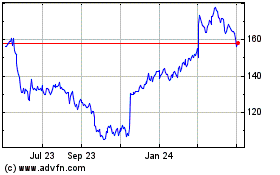Target and Lowe's Tech Executives Credit Talent, Culture for Insourcing Success
January 13 2020 - 8:35PM
Dow Jones News
By Jared Council
NEW YORK -- Large retailers are finding that the right talent
and the right company culture are critical to success as they bring
more software development in-house to stay competitive.
Executives from Lowe's Cos. and Target Corp., who spoke Monday
at the National Retail Federation conference, said they have been
expanding internal technology teams to build everything from
inventory-management systems to point-of-sale software.
The idea is to be more hands-on in tailoring technology to their
customers and employees -- and to do it quickly -- as they compete
with the likes of Amazon.com Inc. in an increasingly digital retail
landscape.
"Two-thirds of growth is coming through digital," said Target
Chief Information Officer Michael McNamara, referring to same-store
sales growth being boosted by initiatives such as Drive Up, which
allows customers to pick up online orders without leaving their
cars. "By and large that is all about technology, and you've got to
be able to build that stuff yourself."
Not everything needs to be done in-house, but companies should
opt to build technologies that are core to their businesses, said
Seemantini Godbole, chief information officer at Lowe's.
"Wherever you have secret sauce that you want to put your
fingerprints on, for your customer experience or for your own
associates," she said, "I've always believed that you should build
your own technology."
Lowe's over the past several years has developed more of its own
applications and website features, including those related to
inventory, pricing and customer reviews. Last year the company,
which houses about 4,000 engineers, built 20 applications designed
to help in-store associates better guide customers, including where
products are located and best-selling items they might want to
recommend.
When hiring, it is important to identify prospective tech talent
that can learn quickly, Ms. Godbole said.
"[O]ne of the things we are always looking for is learning
ability," she said. "Because technology changes really fast, and
today's hard skill is not so hard two years from now."
At Target, the company's 3,500-person engineering team develops
its own technology, including supply-chain software, merchant
tools, and point-of-sale commerce applications. Before Mr.
McNamara's arrival in 2015, those particular systems were developed
externally.
Shifting software development internally involved reducing
reliance on third-party contractors. Mr. McNamara said when he
arrived, the company's engineering team was made up of 10,000
people, roughly 70% of whom were external contractors. Today, about
10% of the 3,500-person team are contractors.
Mr. McNamara said instilling a culture of speed was key to
developing technology in-house. To that end, he helped introduce
agile practices -- which involves quickly iterating and testing
software features -- and other methodologies.
The result has been faster development cycles. For point-of-sale
software built by Target's technology team, for instance, releasing
two or three product updates in a year used to be a heavy lift, Mr.
McNamara said. Today, he said his team releases updates weekly,
"and we could do it on a daily basis if we so chose."
"We can produce technology now at a speed that was unimaginable
to me just a few years ago," he said. "And that speed and that kind
of culture of change is what really has accelerated over the last
few years."
Write to Jared Council at jared.council@wsj.com
(END) Dow Jones Newswires
January 13, 2020 20:20 ET (01:20 GMT)
Copyright (c) 2020 Dow Jones & Company, Inc.
Target (NYSE:TGT)
Historical Stock Chart
From Mar 2024 to Apr 2024

Target (NYSE:TGT)
Historical Stock Chart
From Apr 2023 to Apr 2024
